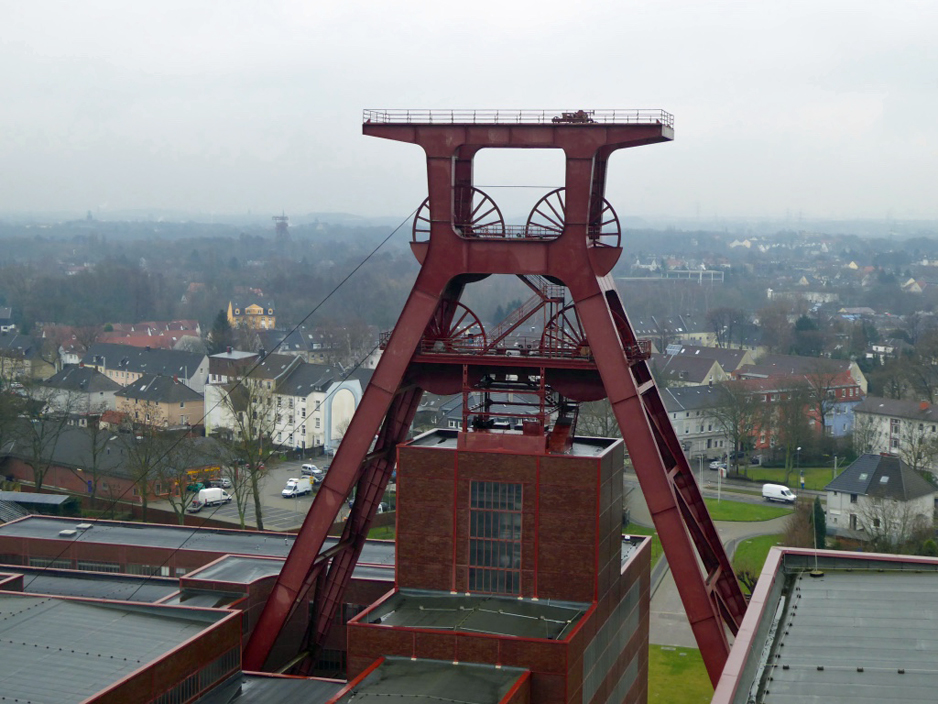The German Football Route
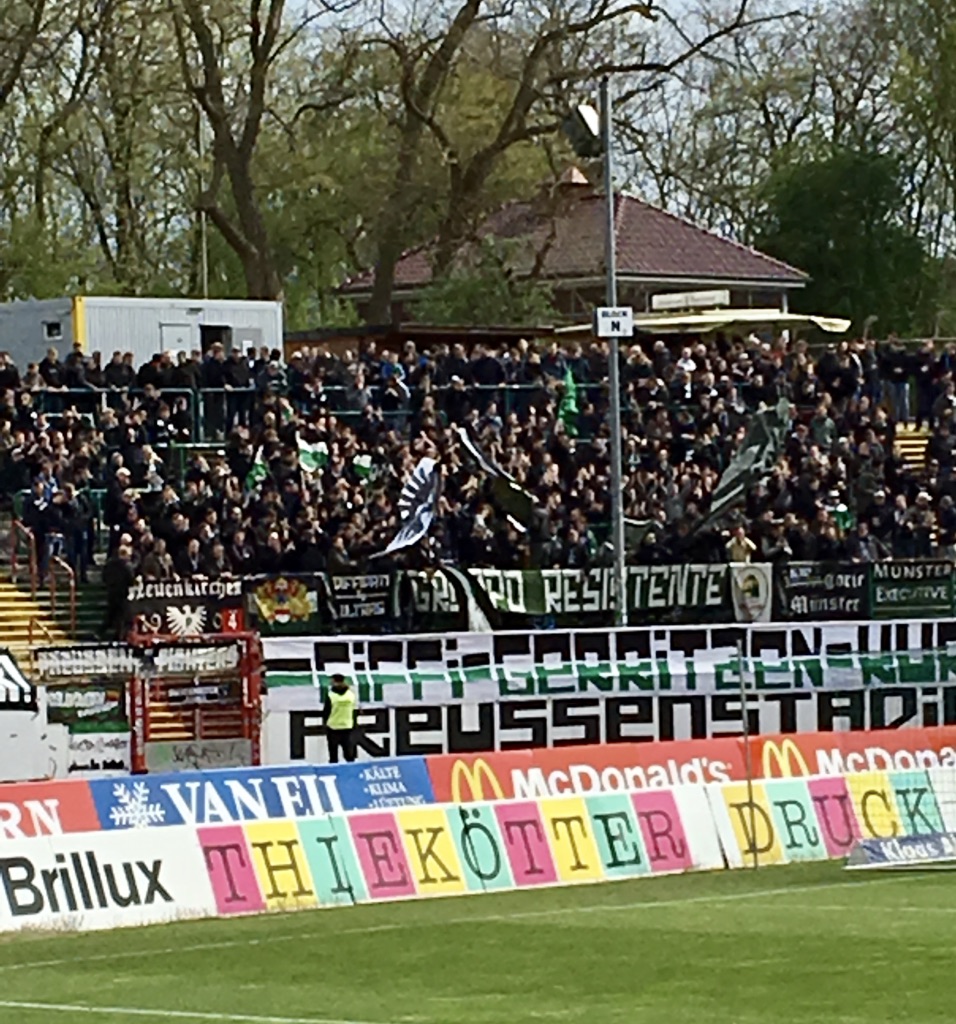
A football tour through North Rhine Westfalia – Germany’s biggest state.
Germany is a federation of 16 states called Bundesländer. The state with the biggest population is called North Rhine-Westphalia. It is home to nearly 18 million people and covers 34,083 km.
It includes four of Germany’s biggest ten cities (Cologne, Düsseldorf, Dortmund, Essen) as well as the biggest metropolitan area in Europe (the Ruhrgebiet).
And it’s the ideal place for a football tour.
The heartland of German football.
The region’s top teams are famous across the world. Clubs like 1 FC Köln, FC Schalke 04, Borussia Mönchengladbach, Borussia Dortmund and Bayer 04 Leverkusen are household names on every continent. And, of course, North Rhine-Westphalia is also home to clubs with a special place in football history. VfL Bochum, Fortuna Düsseldorf, MSV Duisburg are just three examples.
No other Bundesland contains as many big, successful clubs. Seven teams from the state play in the Bundesliga, three play in the 2 Bundesliga and four in the 3 Liga. In 2018/19 teams from the region ended the season in second, fourth and fifth position in the Bundesliga. Four of the ten teams with the highest Bundesliga attendance are based here. Borussia Mönchengladbach, Borussia Dortmund and FC Schalke 04 are amongst the richest football clubs in the world.
The history of German football is inextricably linked to the history of this region. As in many countries, the emergence of football as a mass sport came at the same time as industrialisation and the rapid growth of large cities. And so if you want to understand the football and its culture you also need to learn a bit about the history of the places where it was born and developed.
A sporting and historical journey
The German Football Route will help you do just that. It is an 800 km journey by car or bicycle across the entire region of North Rhine-Westphalia and provides a superb introduction to the history of German football and its social and industrial roots.
Starting in Aachen in the west, it passes through 15 cities that have featured prominently in Germany’s football history. It takes you to stadiums, pubs, cafes, museums and monuments. As well as today’s big names the route includes sleeping giants from the past. Passing through major population centres, historic and brand new towns and cities, yYou learn about the key role the region has played in Germany’s history, as well as about the history of its football clubs and their fans.
You may well not want to visit every town and every club on this route, but it might help you plan a few football trips to Germany next season. You can get detailed information from the Football Route website, but here is a very brief introduction to get you started.
The German Football Route
Aachen
The football tour starts in the west, close to the border with Belgium.
Aachen’s history dates back to the early middle ages and for many years it was the home of the German kings who ruled the Holy Roman Empire. It is also home to Alemannia Aachen. Founded in 1900, it is one of Germany’s oldest football clubs. The club currently plays in the fourth-tier Regionalliga West (finishing 6th in 2017/18). Despite its relatively lowly status, Alemannia Aachen has a large, passionate and hugely loyal fanbase. The average attendance of 6,018 at the Tivoli stadium was the second highest for the league in 2017/18.
Cologne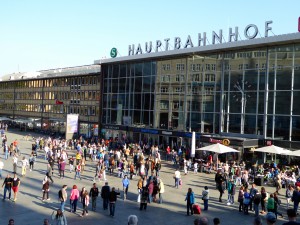
Now we head for the river Rhine and the huge, bustling city of Cologne. Even if you aren’t interested in the football you should still go to Cologne for its massive cathedral, thriving nightlife and local beer – Kölsch. Of course, it is also home to the illustrious 1 FC Köln who play at theRheinergie Stadion. Neighbours Fortuna Köln, also have a rich and impressive history but have fallen on hard times and are currently in the Regionalliga West. Their stadium is called Südstadion. Another neighbour is recently-promoted Viktoria Köln, who play in the 3 Liga.
Leverkusen
A bit further north, between Cologne and Düsseldorf, is the town of Leverkusen. Pharmaceutical giant Bayer is based here and when Bayer employees formed a football club they called it Bayer Leverkusen. It is one of the smaller Bundesliga clubs, and has a reputation for never quite achieving its full potential. But Bayer 04 Leverkusen has performed consistently well in recent years, finishing 4th in the 2018/19 Bundesliga. The stadium is called the Bay Arena. This is an ideal venue for travellers completely new to German football.
Mönchengladbach
We now leave the river and head west to Mönchengladbach – home to the iconic Borussia Mönchengladbach. Formed 1900 this is one of Germany’s oldest, best known and most successful football clubs. Their stadium – the Borussia Park – is always full to capacity and a fantastic atmosphere is guaranteed.
Düsseldorf
Düsseldorf is the regional capital. There is plenty to do and see here before and after the football. It has a thriving nightlife. The Altstadt is reputed to be 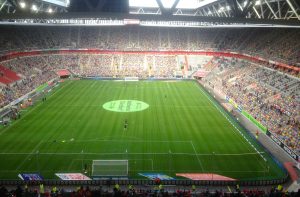 the longest bar in the world. A visit to the Esprit Arena to watch Fortuna Düsseldorf is well worth a visit. This is one of Germany’s most modern and fan-friendly stadiums and there is always a really good atmosphere.
the longest bar in the world. A visit to the Esprit Arena to watch Fortuna Düsseldorf is well worth a visit. This is one of Germany’s most modern and fan-friendly stadiums and there is always a really good atmosphere.
If you want to find out more about Düsseldorf, see my blog post: Making the most of your football trip – Starting from Düsseldorf
Wuppertal
Wuppertal is famous for its Schwebebahn – a rail system where train and carriages hang from the rails. It is also home to Wuppertaler SV who play at Stadion am Zoo. Nicknamed the lions, Wuppertal has a long and rich history which goes back to the end of the 19th century. The club’s greatest achievement was spending three years in the Bundesliga in the 1970s. They have recently been promoted to the fourth tier Regionalliga West.
Into the Ruhrgebiet
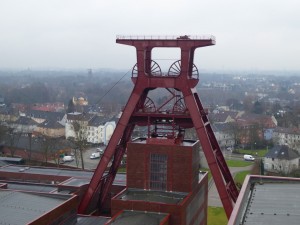 The next stage of our football tour is the Ruhrgebiet – originally Germany’s industrial powerhouse, this is the largest metropolis in Europe. Although de-industrialisation has totally changed the region, the Ruhrgebiet remains the perfect destination for anyone who wants to experience German football culture at its very best. It is also perfect if you want to find out more about German industrial history.
The next stage of our football tour is the Ruhrgebiet – originally Germany’s industrial powerhouse, this is the largest metropolis in Europe. Although de-industrialisation has totally changed the region, the Ruhrgebiet remains the perfect destination for anyone who wants to experience German football culture at its very best. It is also perfect if you want to find out more about German industrial history.
If you want to know more about the Ruhrgebiet see my blog post : The Ruhrgebiet : perfect destination for the football tourist.
Duisburg
Its riverside location and good connections to canals and railways made Duisburg a vital regional export hub for most of the last century. The Innenhafen was the biggest inland harbour in the world. As a result of industrial and economic change it fell into disuse in the mid-sixties and for a time was derelict and abandoned. Imaginative renovation based on designs by British architect Norman Foster has transformed the area into one of the city’s key attractions. There is a marina, an art museum, a synagogue and a Jewish community centre, and a large collection of restaurants and bars. The huge contribution made by the Innenhafen to the region’s industrial past is not forgotten. It is a key destination of the Ruhrgebiet’s Industrial Heritage Route, which takes visitors by car or bicycle on a tour of former industrial sites. There are information boards at every turn which explain different aspects of the harbour.
MSV Duisburg was founded in 1902. They were founder members of the Bundesliga and played in the top tier from 1963 to 1982. Since then Duisburg has been one of Germany’s elevator teams – moving up and down the divisions. They currently play in the 3. Liga. If you decide to watch a game at the Schau ins Land Arena you will join a large, passionate crowd and experience a brilliant atmosphere.
Essen
Essen is one of Germany’s largest cities. It emerged around the coal and steel industries and is still home to famous multinationals like Thyssen. The Zollverein used to be a huge mine and coke plant. It is now a World Heritage Site. If you want to understand how this region developed this is the place to go. (You will also get a brilliant view from the top).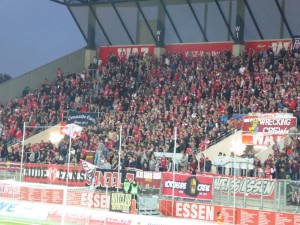
Rot Weiss Essen is another of the region’s sleeping giants. It achieved its greatest successes in the 1950s when it won both league and cup, and its most famous player – Helmut Rahn – scored Germany’s winning goal in the 1954 World Cup final. Since those heady days, the club has fallen on hard times and currently plays in the fourth tier Regionalliga West. If you decide to pay a visit to the Stadion Essen you will find yourself in a really modern venue amongst a surprisingly large crowd.
Oberhausen
Oberhausen is known all over Germany for its gasometer. 117 meters tall it dominates the city skyline. Now it’s a venue for exhibitions and events, but even when nothing is on visitors flock there to see the superb view from the top or hear the intriguing echo on the inside.
Oberhausen is also the home of Rot-Weiß Oberhausen, yet another venerable football club. Although founded in 1904 it can trace its roots right back to 1873 and the formation of a gymnastics club. The club’s most successful period was the late 1960s when it spent three years in the Bundesliga. Since then it has moved up and down the divisions and battled with financial difficulties. The club plays at the NiederRheinstadion.
Bochum
The city of Bochum is twinned with Sheffield in England– an almost perfect match.
Both cities
- were the heart of their coal and steel industries.
- suffered heavy bombing during the war.
- have endured the lingering death of their heavy industry and the accompanying hardship, social turmoil and economic restructuring.
- have been hit by the recent recessions.
Both cities also have a long and proud sporting history. Hallam FC – founded in 1860 and still playing – has the oldest football ground in the world, and the first ever inter-club game of football was played between Sheffield FC and Hallam FC. The idea of a sports club in Bochum (VfL Bochum) was first discussed in 1848 and the club itself was formed the next year.
VfL Bochum is by no means the most successful or the biggest football club in Germany, and at the moment it’s not even in the top division. But if you want to see football played and watched with passion, pride and commitment this is the club for you.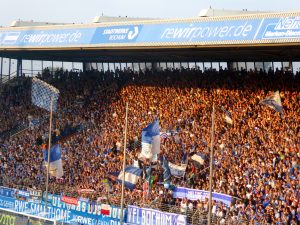
The club motto is: “In Bochum from Bochum for Bochum”
The club website is passionate about its local identity and tradition:
“People from Bochum are our supporters and our supporters are from Bochum. Because being from Bochum means to declare your support for the Ruhrgebiet and its attitude towards life: to work hard, to be self-confident and to treat each other honestly.
Our history and origin is our guide: blue and white are our colours, the Ruhrgebiet our region, Bochum our town, and Castroper Straße our home!”
Gelsenkirchen
Gelsenkirchen is in the heart of the Ruhrgebiet. This former mining town is home to Schalke 04, one of the oldest, biggest and best-known clubs in the Bundesliga. It is also one of the most successful. Seven times German champions, Schalke has won the German cup five times and the UEFA Cup once.
Schalke 04 was established by a group of young miners when football in Germany was in its infancy. It went on to dominate football in the 1920s and 1930s It was the Barcelona of its day, delighting huge crowds, winning trophy after trophy and producing the first football superstars.
Today Schalke 04 is a thriving, modern business. It is Germany’s second-biggest sports club and reputed to be the twelfth wealthiest football club in the world. It has nevertheless remained true to its origins.
The tightly-knit working class community and the pits that once provided a seemingly endless supply of players and fans are gone, but the club’s history is cherished. The people who built the town and its football club are still remembered at every home game. When you go to watch Schalke 04 at the superb Veltins Arena, you don’t just attend an exciting sporting event. You join a celebration of history, community and shared values.
If you want to know more about Schalke see my blog post: Understanding FC Schalke 04
Dortmund
Dortmund has a population of 589,283, making it the largest city in the region and the eighth largest in Germany. Until the 1970s it was famous for coal, steel – and beer. Now the city focusses on high-tech industries such as robotics, biomedicine and microsystems. It is a vibrant, multicultural city with shops, bars, restaurants, parks
Dortmund is also the home of Ballspiel Verein Borussia 09 e.V. Dortmund – also known as Borussia Dortmund, or simply BVB. According to Forbes Borussia Dortmund is the 11th most valuable football club in the world. It has been in the Bundesliga for 49 years and is fourth in the all-time table.
With an average of over 80,000, the club has the highest attendance in the Bundesliga. It has well over 100,000 members, making it one of the most supported clubs in the world. There are 55,000 season ticket holders and a waiting list of 10,000.
They say that the Signal Iduna Park is one of the most beautiful football stadiums in the world. It also one of the largest, with a capacity of 81,358, and the atmosphere at the is recognised as something really special. There are 25,000 standing places – making the south stand the largest standing-only section in Germany. And the ‘yellow wall’ one of the most imp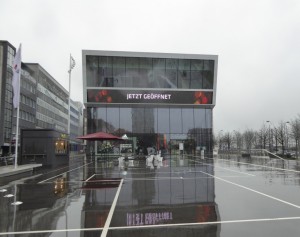 ressive sights anywhere in the football world.
ressive sights anywhere in the football world.
If you go the Signal Iduna Park, pay a visit to the Borusseum – a museum dedicated to the history of this huge club.
And if you are in Dortmund, you should make time to go the German Football Museum, which is beside the central station.
Final Stages
Münster
We now leave the Ruhrgebiet and head towards the university town of Münster
300,000 people live in Münster – and 50,000 of them are students. It’s an old, historic city that goes back to the early middle ages and its rich history is reflected in its many old buildings.
Münster claims to be the bicycle capital of Germany. The bicycle is the most common way for residents to get around and there is a car-free ring around the city centre. The city also recently won an award for being one of the nicest places to live in the world.
SC Preußen 06 Münster began in 1906 and it was a founding member of the German Bundesliga when it was formed in 1963. The club’s greatest achievement was to come second in the German championship in 1951. In recent years Preußen Münster has struggled with financial difficulties off and inconsistent performance on the pitch. For a time they dropped out of the professional leagues altogether. Recent improvements have seen promotion to the 3 Bundesliga in 2011 and steady top-half finishes every year. They play in the Preußenstadion and last season achieved a highly respectable average attendance of 7,220
Bielefeld
The football tour ends in the north-eastern corner of the state, ion the edge of the ancient Teutoburg forest in the city of Bielefeld. This city of 327,000 is the home of baking products company Dr Oetker and manufacturing giant Schüco.
The football team is called Armenia Bielefeld. Founded in 1905, this is another of Germany’s oldest clubs, with a proud history. They first played in the Bundesliga in 1967/68, but since then have been a classic ‘elevator’ club. Heroic and successful promotion campaigns have regularly been followed by unsuccessful battles against relegation. The club has achieved a few successful spells in the top tier but has also at times dropped out of the professional leagues altogether. Despite repeated financial difficulties and the occasional threat of bankruptcy, the club has survived. Long-suffering Bielefeld fans are currently enjoying a period of success. In 2014/15 a run of thrilling victories over bigger clubs took them to the semi-final of the German Cup. Bielefeld were 3 division champions the same year and moved up to the 2 Bundesliga. Their stadium, which is named after their main sponsor, is called the Schücoarena.
And that is the German Football Route. It would be hugely ambitious to follow, in order, every kilometre of the route or to visit every single place of interest or every football club that is introduced. But it does provide a really helpful frame of reference for anyone wanting to find out more about this fascinating region.

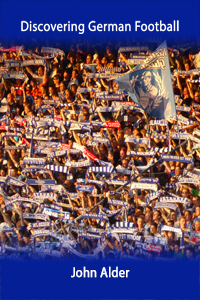
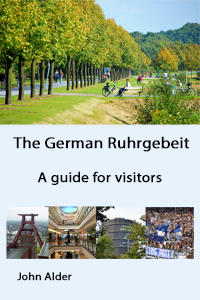
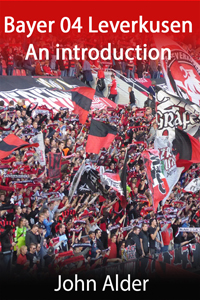
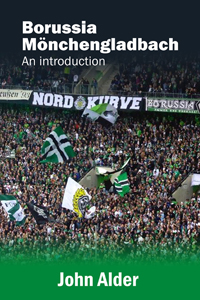
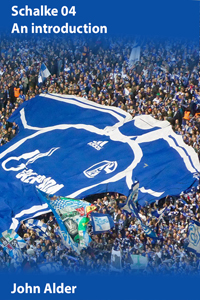
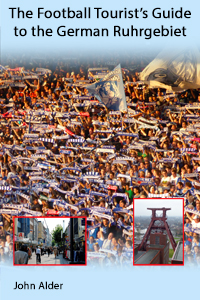

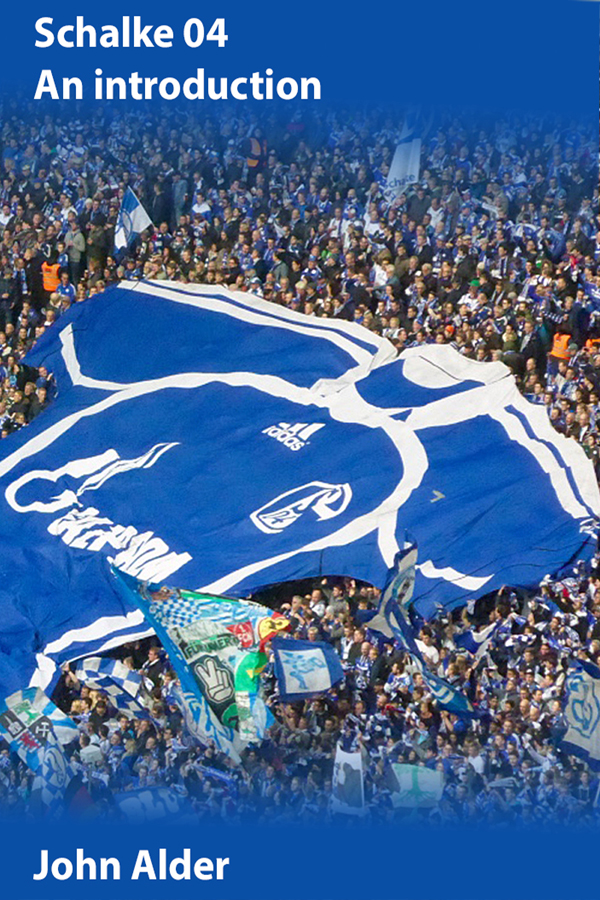
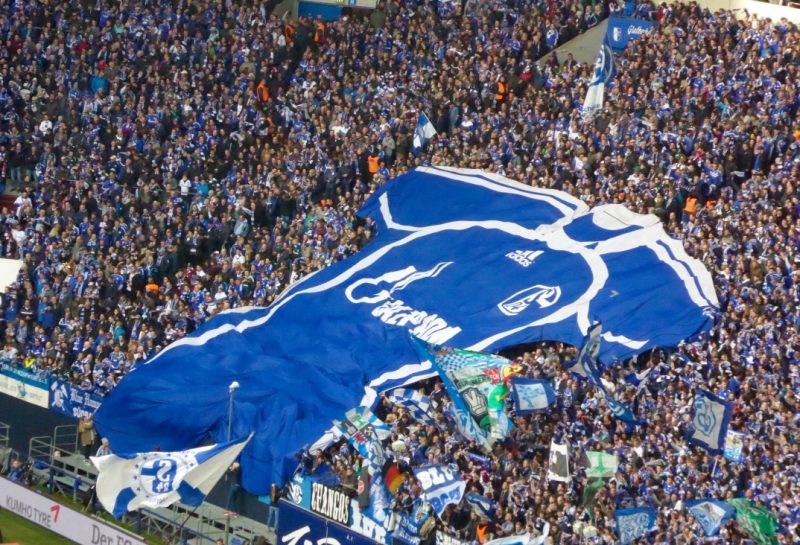
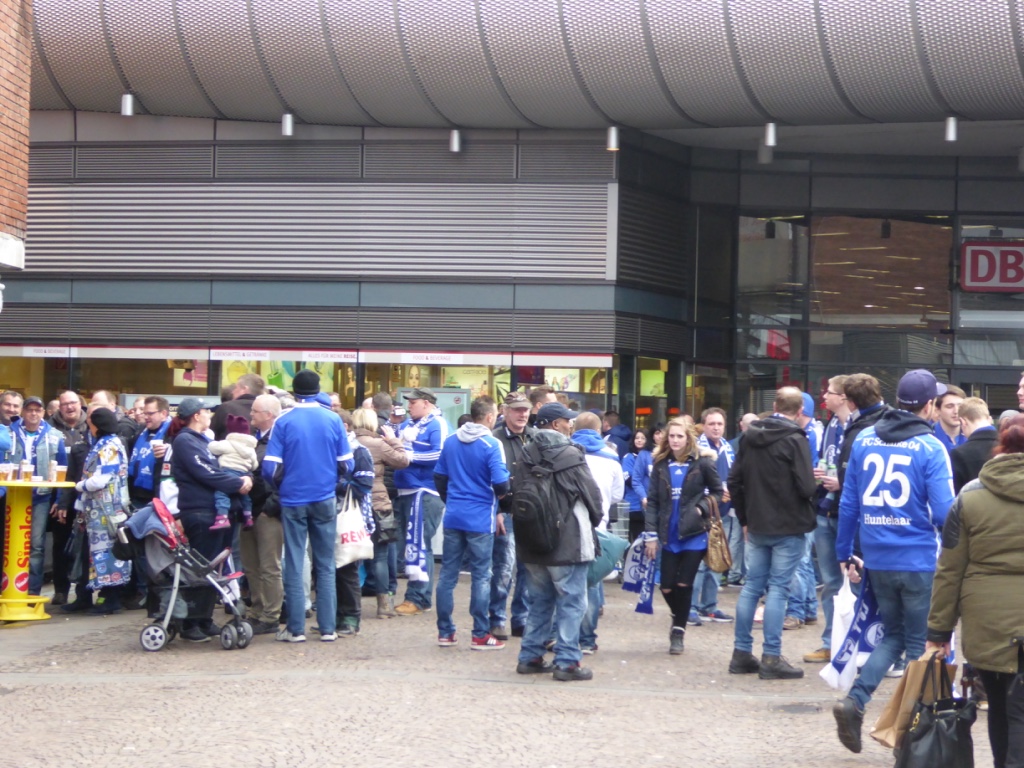
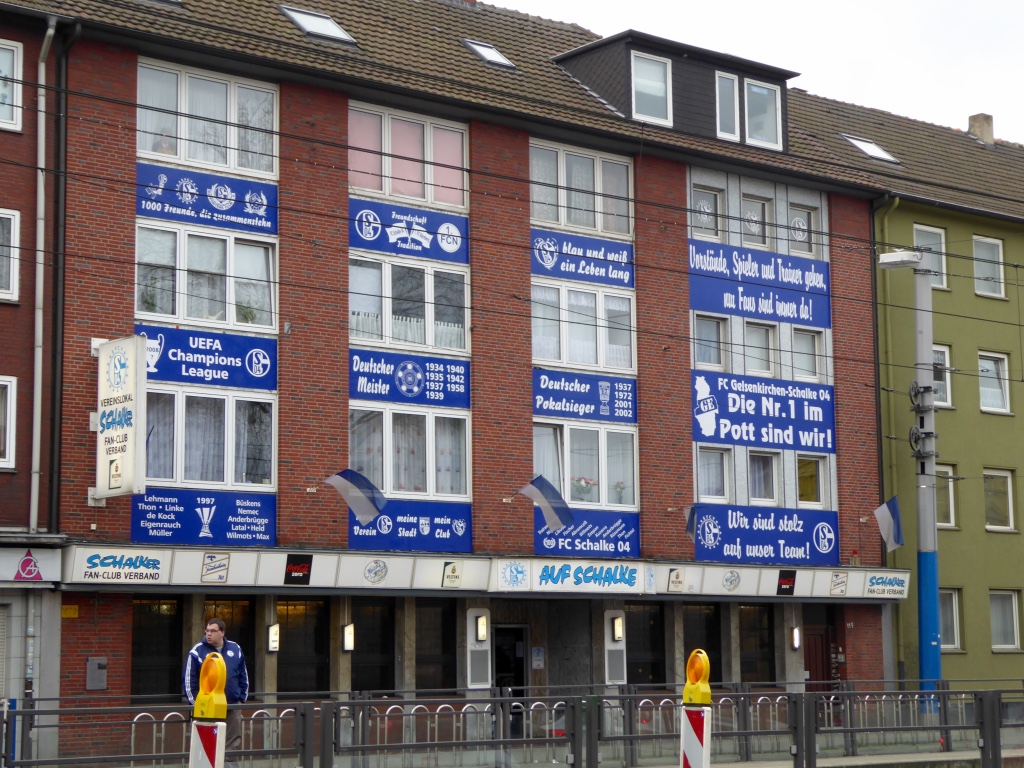
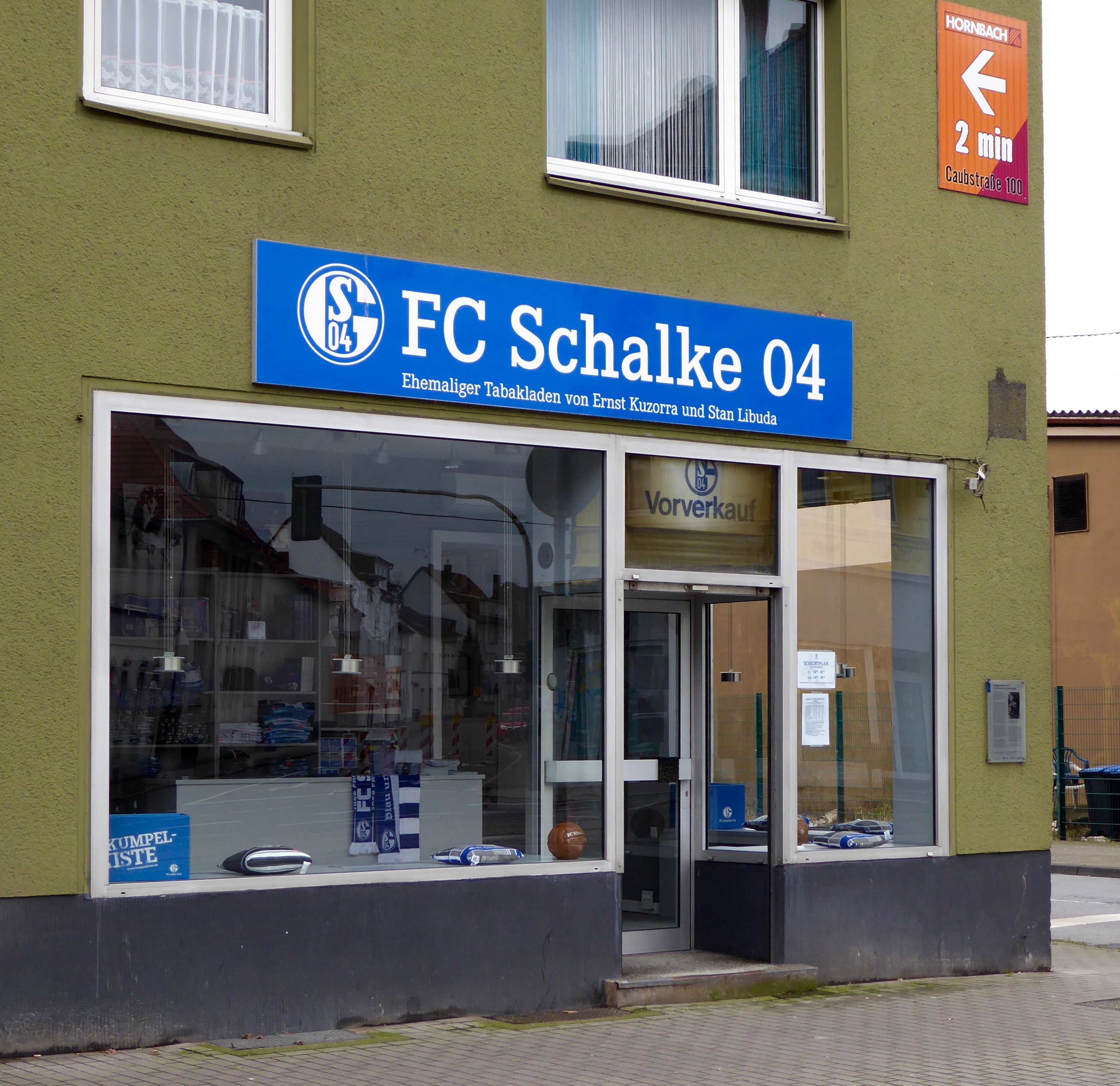
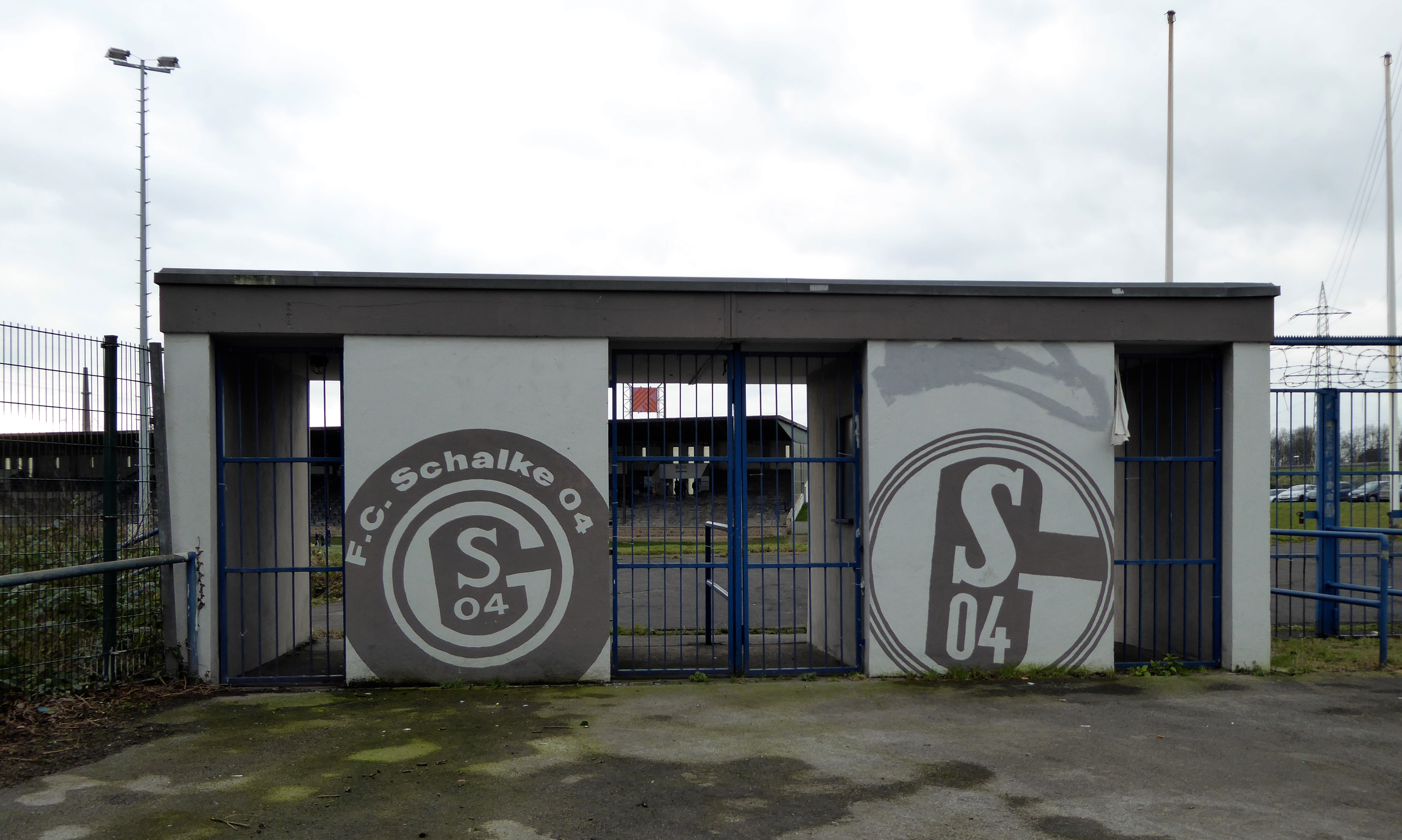
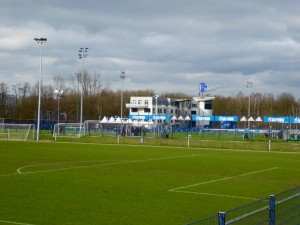 inside yet. If you have followed my advice and arrived extra early it won’t be open anyway, but even if it is, follow the pathways round to the left and walk through the training pitches. The fact that these are just open on match days for fans to wander around is remarkable in itself – but just as impressive is what is available for them. At the far side of the pitches there is a fan shop, of course, but also a huge bar with a massive outside area serving beer and sausages. The message from the club is clear – we value and welcome our fans.
inside yet. If you have followed my advice and arrived extra early it won’t be open anyway, but even if it is, follow the pathways round to the left and walk through the training pitches. The fact that these are just open on match days for fans to wander around is remarkable in itself – but just as impressive is what is available for them. At the far side of the pitches there is a fan shop, of course, but also a huge bar with a massive outside area serving beer and sausages. The message from the club is clear – we value and welcome our fans.
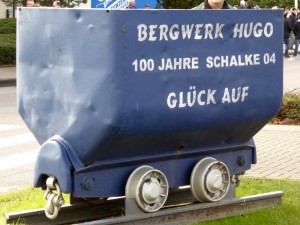
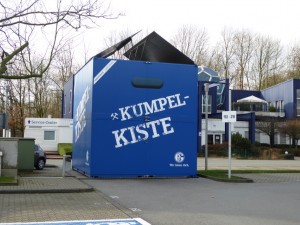
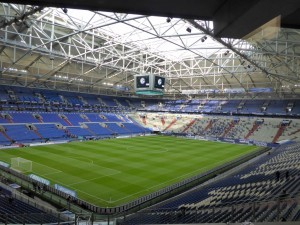 ns show footage of games from the early days until the present. And if you enjoy nothing else in the museum, I guarantee you will be blown away by the view of the stadium from here, and which justifies the 5 euro entrance fee on its own.
ns show footage of games from the early days until the present. And if you enjoy nothing else in the museum, I guarantee you will be blown away by the view of the stadium from here, and which justifies the 5 euro entrance fee on its own.
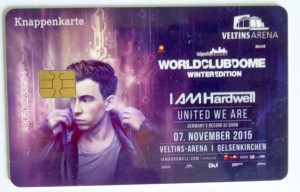 different at Schalke is that you can’t use cash. You have to go to one of the many kiosks and pick up and load a Knappenkarte. It then works just like a debit card – and if you don’t spend all the money on the card you can get it back before you leave.
different at Schalke is that you can’t use cash. You have to go to one of the many kiosks and pick up and load a Knappenkarte. It then works just like a debit card – and if you don’t spend all the money on the card you can get it back before you leave.